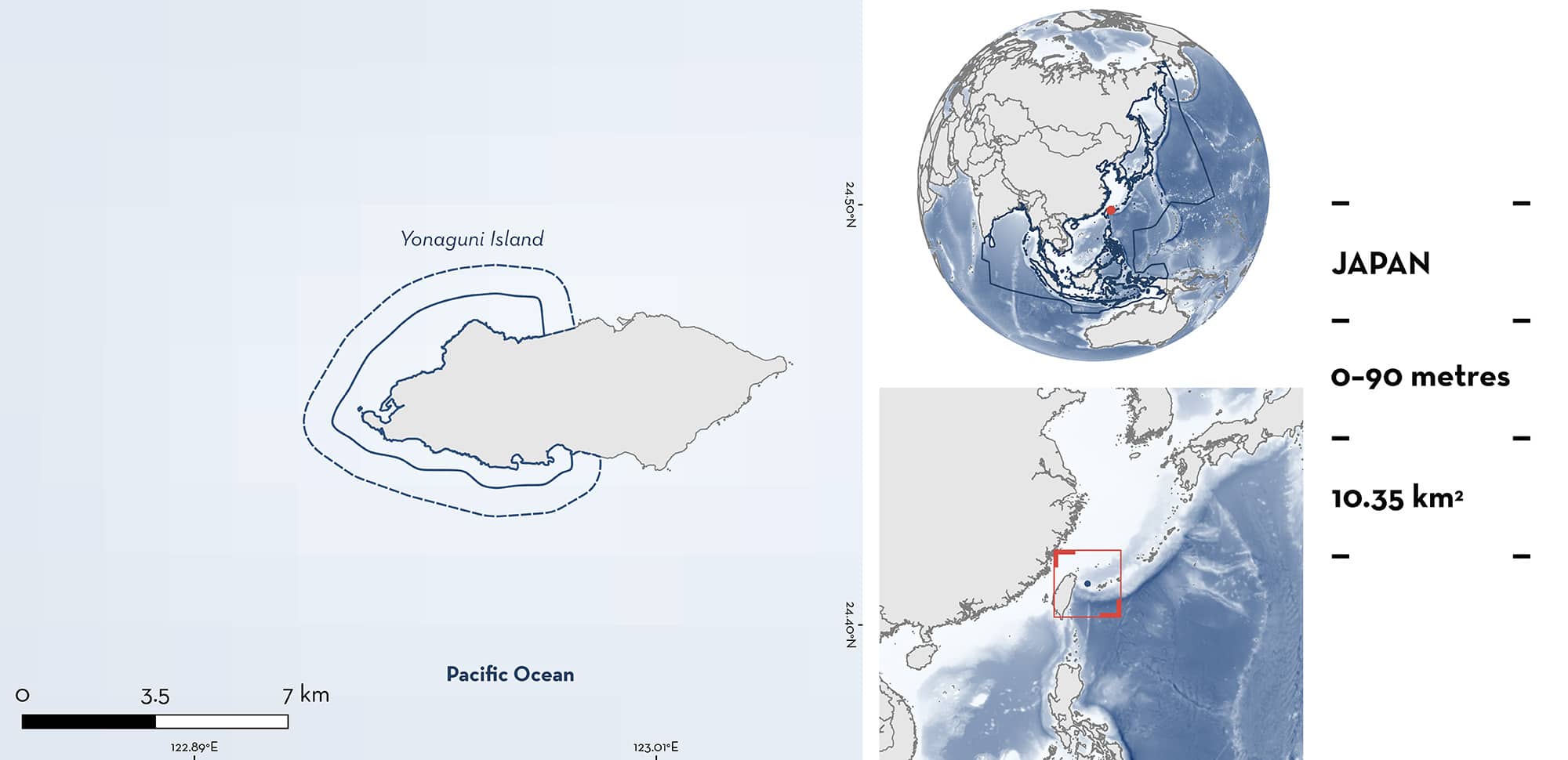ISRA FACTSHEETS
ISRA FACTSHEETS
ASIA REGION
Yonaguni Island
Summary
Yonaguni Island, located in the Ryukyu Arc, is part of the Yaeyama Islands, and is the westernmost island of Japan. The area is characterised by rocky coasts and is under the influence of the Kuroshio Current. This area overlaps with the Southwest Islands Ecologically or Biologically Significant Marine Area (EBSA) and the Yonaguni Island EBSA. Within this area there are: threatened species and undefined aggregations (Scalloped Hammerhead Sphyrna lewini).
Download factsheet
Yonaguni Island
DESCRIPTION OF HABITAT
Yonaguni Island, located in the Ryukyu Arc, is part of the Yaeyama Islands, and is the westernmost island of Japan (Koeda et al. 2016). It is an elliptical island of 28 km2 with a coastline composed of rocky cliffs (Koeda et al. 2016). Cape Irizaki is the westernmost part of the island.
Yonaguni Island is located on the pathway of the Kuroshio Current (Koeda et al. 2016). The Kuroshio Current is one of the western boundary currents of the subtropical North Pacific and is the dominating current in the East China Sea. It originates in the eastern Philippines, flows northward along the west boundary of the Pacific Ocean, and enters the East China Sea between Taiwan and Ishigaki (Zhang et al. 2012). This current is one of the most important routes for poleward heat transport, and contributes greatly to the productivity of marine ecosystems along in the coastal regions of its route. The Kuroshio Current undergoes a significant spatial and temporal variability along its route, influencing greatly the biological resources availability off southwest Japan (Andres et al. 2015; Lizarbe Barreto et al. 2021).
Yonaguni Island sits within the Southwest Islands Ecologically or Biologically Significant Marine Area (EBSA; CBD 2024) and the Yonaguni Island EBSA (Ministry of the Environment, Government of Japan 2024).
This Important Shark and Ray Area is benthopelagic and is delineated from inshore and surface waters (0 m) to 90 m based on the depth range of the Qualifying Species in the area.
CRITERION A
VULNERABILITY
The one Qualifying Species within the area is considered threatened with extinction according to the IUCN Red List of Threatened Species. The Scalloped Hammerhead is assessed as Critically Endangered (Rigby et al. 2019).
CRITERION C
SUB-CRITERION C5 – UNDEFINED AGGREGATIONS
Yonaguni Island is an important aggregation area for one shark species.
Based on local ecological knowledge (LEK) from dive centres operating in Yonaguni, aggregations of up to 200 Scalloped Hammerheads are regularly and predictably recorded around Cape Irizaki (A Ramos pers. obs. 2015–2023). Aggregations are seasonal between December and March and are mostly comprised of large-bodied females (estimated sizes between 200–400 cm total length [TL]; size-at-maturity 200–250 cm TL; Ebert et al. 2021). Aggregations are observed in the water column at depths of 20–50 m (where the bathymetry is 30–90 m), occurring with a higher probability when current flows in a westward direction (YDS 2023; A Ramos pers. obs. 2015–2023). These aggregations could potentially be related to reproduction, as a place for pregnant females to rest, since large females suspected to be pregnant (presence of extended abdomens) are observed regularly in the area (A Ramos pers. obs. 2015–2023). Additional information is needed to understand the nature and function of these aggregations.
Download factsheet
SUBMIT A REQUEST
ISRA SPATIAL LAYER REQUEST
To make a request to download the ISRA Layer in either a GIS compatible Shapefile (.shp) or Google Earth compatible Keyhole Markup Language Zipped file (.kmz) please complete the following form. We will review your request and send the download details to you. We will endeavor to send you the requested files as soon as we can. However, please note that this is not an automated process, and before requests are responded to, they undergo internal review and authorization. As such, requests normally take 5–10 working days to process.
Should you have questions about the data or process, please do not hesitate to contact us.


